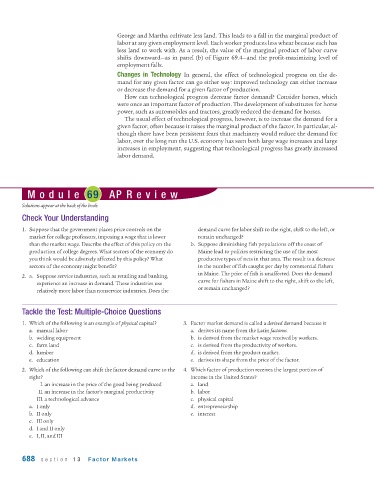Page 730 - Krugmans Economics for AP Text Book_Neat
P. 730
George and Martha cultivate less land. This leads to a fall in the marginal product of
labor at any given employment level. Each worker produces less wheat because each has
less land to work with. As a result, the value of the marginal product of labor curve
shifts downward—as in panel (b) of Figure 69.4—and the profit-maximizing level of
employment falls.
Changes in Technology In general, the effect of technological progress on the de-
mand for any given factor can go either way: improved technology can either increase
or decrease the demand for a given factor of production.
How can technological progress decrease factor demand? Consider horses, which
were once an important factor of production. The development of substitutes for horse
power, such as automobiles and tractors, greatly reduced the demand for horses.
The usual effect of technological progress, however, is to increase the demand for a
given factor, often because it raises the marginal product of the factor. In particular, al-
though there have been persistent fears that machinery would reduce the demand for
labor, over the long run the U.S. economy has seen both large wage increases and large
increases in employment, suggesting that technological progress has greatly increased
labor demand.
Module 69 AP Review
Solutions appear at the back of the book.
Check Your Understanding
1. Suppose that the government places price controls on the demand curve for labor shift to the right, shift to the left, or
market for college professors, imposing a wage that is lower remain unchanged?
than the market wage. Describe the effect of this policy on the b. Suppose diminishing fish populations off the coast of
production of college degrees. What sectors of the economy do Maine lead to policies restricting the use of the most
you think would be adversely affected by this policy? What productive types of nets in that area. The result is a decrease
sectors of the economy might benefit? in the number of fish caught per day by commercial fishers
in Maine. The price of fish is unaffected. Does the demand
2. a. Suppose service industries, such as retailing and banking,
curve for fishers in Maine shift to the right, shift to the left,
experience an increase in demand. These industries use
or remain unchanged?
relatively more labor than nonservice industries. Does the
Tackle the Test: Multiple-Choice Questions
1. Which of the following is an example of physical capital? 3. Factor market demand is called a derived demand because it
a. manual labor a. derives its name from the Latin factorus.
b. welding equipment b. is derived from the market wage received by workers.
c. farm land c. is derived from the productivity of workers.
d. lumber d. is derived from the product market.
e. education e. derives its shape from the price of the factor.
2. Which of the following can shift the factor demand curve to the 4. Which factor of production receives the largest portion of
right? income in the United States?
I. an increase in the price of the good being produced a. land
II. an increase in the factor’s marginal productivity b. labor
III. a technological advance c. physical capital
a. I only d. entrepreneurship
b. II only e. interest
c. III only
d. I and II only
e. I, II, and III
688 section 13 Factor Markets

